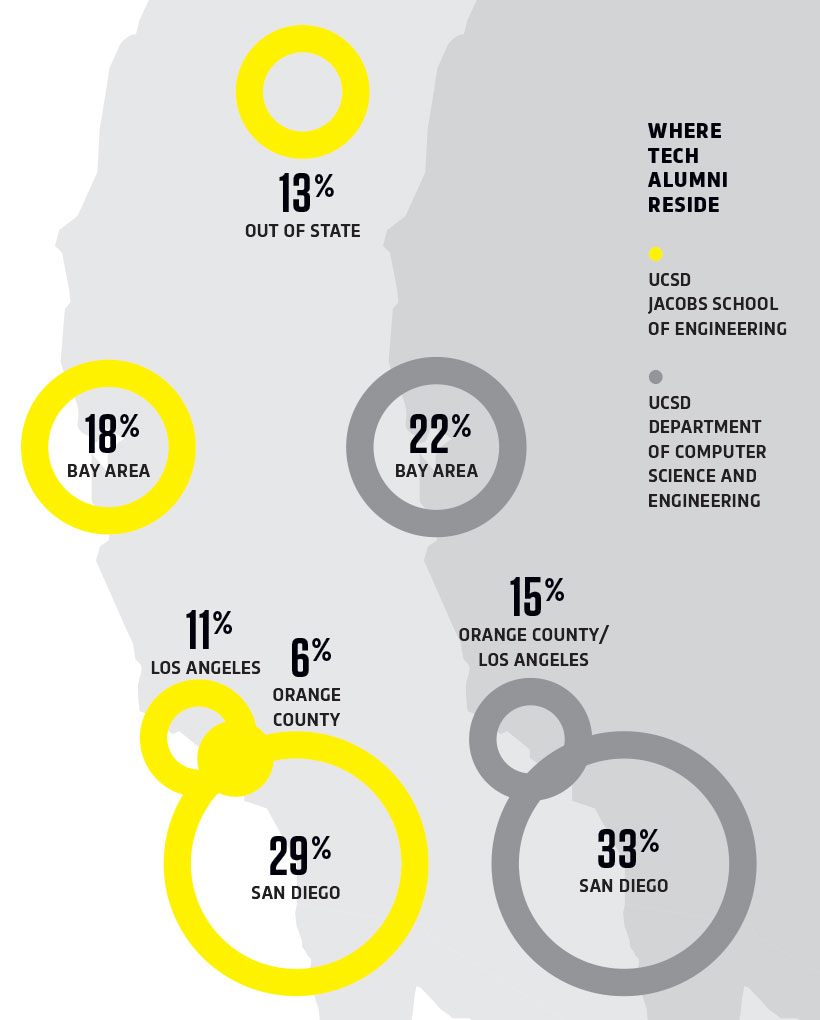San Diego is known as the genomics capital of the world, drone capital of the country, a center of precision medicine, a major spoke on the cyber-security wheel, and a hub for “the internet of things.” Then there’s the weather, seaside location, and the beer. Which makes it all the stranger that the city’s tech workers are supposedly leaving at an alarming rate—enough for the New York Times to call it an “exodus of the young tech class.”
Sounds drastic. But is it? Turns out the data shows this isn’t happening at a historically high rate, and is actually lower than in comparable metro areas.
In fact, Rajesh Gupta, former chair of UC San Diego’s department of computer science and engineering, sees the opposite happening.
Crunching the Numbers
“I think ‘exodus’ is the wrong word,” Gupta says, “because it implies that they were not doing that and now they are. It was always the case that a certain percent left for the Bay Area or Washington or other tech centers. But what is happening now is exactly the opposite: Now more people are staying back.”
According to the UCSD alumni office, 29 percent of the Jacobs School of Engineering’s 29,000 alumni still live in San Diego County. Six percent now call Orange County home and 11 percent Los Angeles, for a total of 46 percent residing in Southern California. Compare that to 18 percent in the Bay Area, and only 13 percent now out of state.
Fully one-third of the school’s Department of Computer Science and Engineering alumni live in San Diego. An additional 15 percent reside in Orange County or L.A., and 22 percent have moved up to the Bay Area.
San Diego State University reports even higher rates, though they don’t currently have data specifically for graduates with technical or STEM degrees. Of all the students graduating with bachelor’s degrees in spring 2016, nearly 68 percent planned to stay and work in the region.
Rory Moore, CEO of EvoNexus, says he has heard secondhand that it’s hard to keep computer science and electrical engineering students who don’t have family in town.
“You have places like Facebook, Google, Microsoft, Amazon, Apple, very actively recruiting talent here. So the students that come here for school may not have a compelling reason to stay here once they’ve got their degree.” But he adds that once someone gets a job or put down roots in San Diego, it’s much easier to keep them here.

Life Sciences Anchor
Retention numbers are impressive in the life sciences world. Liisa Bozinovic, executive director of Biocom Institute, says that as of 2014 there were 1,100 life science companies in San Diego, employing about 38,000 people.
Many of them have internship programs focused specifically on training and recruiting local students, and it seems to be working. Bozinovic cited Pharmatek, Vertex, and Illumina as examples.
Pharmaceutical tester and manufacturer Pharmatek has about 200 total employees and takes on 40 student interns a year, 99 percent of whom are from local schools. Of those interns, a quarter of them convert to full-time employees upon graduation. Over the past four years fellow pharmaceutical developer Vertex, which also has roughly 200 personnel, hired 22 people into full-time positions who were originally interns or temps, and half of them were local.
Genomics giant Illumina is a bigger player, hiring for 2,000 positions annually, two-thirds of which are in San Diego. Their internship program started three years ago with between 30 and 50 students, and this year hit 120. A whopping 85 percent of them will convert to full-time employees upon graduation.
“These are PhD and master’s-level students in bioinformatics, molecular biology, biomedical engineering,” Bozinovic says. “They recruit from MIT, Harvard, East Coast schools and it’s never an issue that they’re competing for talent with other areas, that they’re losing talent to other areas because people don’t want to come to San Diego.”
Not All That Glitters is Silicon
Gupta credits the specialization of the San Diego market for part of the shift he’s seen in more young people staying—there aren’t many general IT or computer science companies, but many specialize in the areas of software and network security, data analytics, robotics, and defense, which bodes well during recessions. He says a swing of the work-life balance pendulum has also helped San Diego—younger employees don’t all want the lifestyle made famous in Silicon Valley, such as eating all three meals at your office, or even sleeping there.
Gupta admits that while more recent STEM grads are staying local, the percentage could certainly be improved.
“I think ‘exodus’ is the wrong word, because it implies that they were not doing that and now they are. It was always the case that a certain percent left for the Bay Area or Washington or other tech centers. But what is happening now is exactly the opposite: Now more people are staying back.”— Rajesh Gupta, former chair of UC San Diego’s department of computer science and engineering
“It’s changing, but it’s a slower trickle than it could be. Once we have the trolley coming here, that will bring more life to the area,” he says, referring to the 11-mile trolley extension that will run from downtown through UC San Diego and the UTC area.
“When you go up to the Bay Area and you’re on the 101, there’s board after board after board of one tech company after another, or one tech startup after another—so it gives the impression that you’re in the land where technology lives and breathes.”
You won’t find that in San Diego. Additionally, though our big players like ViaSat and Qualcomm employ many software, computer science, and coding personnel, they’re thought of simply as satellite or hardware chip companies. There’s a disconnect between how potential employees might perceive them and reality.
But Peter Callstrom, president and CEO of the San Diego Workforce Partnership, reiterates that what appears to be a decline may only reflect the same talent shortage that all metropolitan areas are facing.
“Empirically speaking, I don’t see a mass exodus,” Callstrom says. “I know without a doubt it’s a challenge to keep top talent and attract talent because it’s a very competitive marketplace for workforce needs for any kind of business, but I think that’s a global challenge.”
So take heart, San Diego. Not everyone is heading for the hills. Or the Bay.
Startups in Suburbia?
Yes, they are there!

Susie Harborth
Young tech talent is important, but let’s not forget that not all entrepreneurs are 25-year-olds who want to live downtown. Susie Harborth, cofounder of recently opened biotech coworking space BioLabs in UTC, says she actually sees as many serial entrepreneurs in their 40s and 50s in the life sciences sector as she does late 20s and early 30s.
“We see the whole gamut—we see young postdocs all the way up through the 50-year-old executive who’s working on his tenth startup,” Harborth says. “We see a full spectrum.”
Harborth, who’s also a mom living in Carlsbad, found that a community of entrepreneurs does exist above Route 56. “There are a ton of serial entrepreneurs who live in North County, and I think the startup scene is quite vibrant,” she says, adding that one of her friends runs Predictive Biology in Carlsbad.
Harboth chose Carlsbad for several reasons, aside from its proximity to Torrey Pines and UC San Diego. “Carlsbad had so much to offer young families. The beach is there, hiking trails, a lot of greenery; it was accessible to Orange County and L.A.,” she says. “I always felt like it connected me to the rest of Southern California very well, and taking the Amtrak from Solana Beach and Oceanside to points farther north is a real asset not to be underestimated.”
Tags: Education, Features, New York Times, People, Silicon Valley, Startups, Stem, UCSD






























